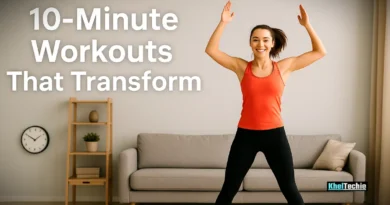Realistic Fitness Goals for College Students: Smart, Achievable, Fun in 2025 Edition!
Why It’s So Hard to Stay Fit in College?
You’re a college student with juggling classes, part-time jobs, social events and endless assignments. By the time you think about hitting the gym, it’s already 10 PM and your motivation has long vanished.
Sound familiar?
The truth is, staying fit in college doesn’t mean working out two hours a day or following celebrity diets, it’s about setting realistic fitness goals that actually work with your lifestyle, not against it.
In this article you’ll discover realistic fitness goals for college students, goals that match your schedule not your motivation. This isn’t about hitting the gym till you drop, it’s about sustainable effective strategies that fit your lifestyle. Whether you’ve never exercised or are a fitness fanatic, keep reading, you’ll soon craft a plan that keeps both your GPA and your gains on track.
Also read – How to Use Technology to Stay Fit

What Are Realistic Fitness Goals for College Students?
Fitness goals are personal targets you set to improve your physical health. But when you’re a student, these goals must align with your schedule, budget, energy levels and academic priorities.
Think of it like planning a road trip:
- You wouldn’t plan a 12-hour drive if you only have three hours to spare.
- Similarly, aiming for intense daily workouts without enough rest or time may lead to burnout.
So, what makes a fitness goal realistic?
| Criteria | Description |
|---|---|
| Specific | ‘I’ll run 2-3 miles’ instead of ‘get fit’ |
| Measurable | Track with a fitness app or journal |
| Achievable | Start with what you can handle |
| Relevant | Fits your class schedule and lifestyle |
| Time-bound | Set a deadline (e.g., ‘by the end of the semester’) |
This is the SMART goal framework and yes, it works.

Why Setting Realistic Fitness Goals Matters for College Students
In today’s fast-paced college life, setting realistic fitness goals is more than just a box to check, it’s an essential lifeline for both body and mind. According to Verywell Health, Start small and smart, aim for 5,000–7,000 steps daily and further, a massive study involving nearly over 96,000 people, found that those who walked at least 7,500 steps daily had a 42% lower risk of depression, even fewer steps helped. For college students dealing with stress or burnout, walking is one of the easiest ways to feel better with no equipment or schedule needed.
But don’t stop there, embrace tools that make habit-building easy. According to ACSM’s 2025 fitness trends, wearable technology and exercise apps are now top drivers of successful goal achievement. These aren’t just fancy gadgets, they’re your pocket-sized accountability partners. Whether tracking your steps, sleep patterns or recovery, they make progress measurable and milestones motivating.
So why does this matter? Because as a college student, you’re juggling academics, social life and maybe even a part-time job. Realistic fitness goals rooted in research and amplified by technology offer a dual win, improved mental health and sustainable physical habits. And the best part? You don’t need a gym membership, just a pair of sneakers and a smartphone. Ready to turn those tiny wins into lifelong habits? Let’s walk this together.

How to Set & Stick to Realistic Fitness Goals (Step-by-Step)
Now that we’ve covered the ‘Why,’ let’s get into the ‘How.’
Step 1: Assess Your Current Lifestyle
Start by asking yourself:
- How many hours do I spend studying each week?
- Do I have access to a gym or outdoor space?
- Am I dealing with chronic stress or fatigue?
Use this info to build a realistic picture of what kind of routine you can sustain.
Step 2: Choose the Right Type of Exercise
You don’t have to love running to be fit. Find something you enjoy:
- Yoga or Pilates – Great for flexibility and mental clarity.
- Bodyweight circuits – Perfect for dorm rooms or tiny apartments.
- Walking/running outdoors – Free and refreshing.
- Group classes – Adds accountability and fun.
Step 3: Set SMART Goals
Pick your goal using SMART (adapted for students):
| SMART Element | College‑Version |
|---|---|
| Specific | ‘Jog 1 mile’ vs ‘get fit’ |
| Measurable | Track with run apps or reps |
| Achievable | Start with two 30‑min sessions weekly |
| Relevant | Choose what motivates you: energy, confidence, focus |
| Time‑bound | Example: ‘Run a mile non‑stop in 6 weeks’ |
Step 4: Schedule It Like a Class
If you treat workouts like you do lectures, writing them in your planner, you’re more likely to stick with them.
Try this:
| Day | Activity | Time |
|---|---|---|
| Monday | 30-minute jog | 7:00 AM |
| Wednesday | Yoga session | 8:00 PM |
| Friday | Bodyweight circuit | After dinner |
Step 5: Track Progress
Use apps like MyFitnessPal, Apple Health or even a simple journal to log your workouts. Tracking gives you visual proof of your consistency.
Celebrate small wins:
- Completing your first 5K
- Doing 10 push-ups in a row
- Sticking to your routine for a full month

Top 5 Common Mistakes College Students Make And How to Avoid Them
Even with the best intentions, many students fall into traps that derail their fitness journey. Here’s how to avoid them:
❌ Setting Unrealistic Expectations
Thinking you’ll hit the gym every day or lose 10 pounds in a week sets you up for failure. Start slow and build momentum.
❌ Ignoring Recovery
Your body needs rest. Overtraining leads to injuries, fatigue and frustration. Aim for at least one full rest day per week.
❌ Skipping Warm-Ups and Cool-Downs
Jumping into intense workouts without warming up increases injury risk. Spend 5–10 minutes stretching or doing light cardio before lifting or running.
❌ Relying Only on Willpower
Motivation fades, Systems last. Create an environment that supports your goals, lay out your workout clothes the night before, find a buddy or use reminder alarms.
❌ Neglecting Nutrition
Exercise alone won’t fix a poor diet. Eat balanced meals with protein, fiber and healthy fats. Snack smart, trail mix, Greek yogurt or fruit beats vending machine chips.
Also read – Best Hydration Drinks for Workouts

Final Thoughts: Your Fitness Journey Starts Now
Setting realistic fitness goals isn’t about being perfect, it’s about showing up consistently, even when you don’t feel like it. College is a unique time to explore, grow and build habits that last a lifetime. So, No more “I’ll start next semester”, The best time to commit to your health is today. Set small, meaningful goals. Track your progress & Celebrate your wins. Whether you’re trying to stay healthy, relieve stress or just feel better in your skin, fitness can be a powerful tool as long as it fits your life.
Ready to Get Started? Drop a comment below with your first fitness goal, we’d love to cheer you on! And if you found this article helpful, share it with a friend who needs a little fitness inspiration.
FAQs: Everything You Want to Know About Realistic Fitness Goals
How Much Time Should I Dedicate to Fitness Weekly?
The World Health Organization recommends at least 150 minutes of moderate-intensity aerobic activity per week, plus muscle-strengthening exercises twice a week.
For students, aim for:
3 sessions of 30–45 minutes
1–2 days of active recovery (walking, stretching)
Can I Get Fit Without Going to the Gym?
Absolutely! You can build strength and endurance with:
- Bodyweight exercises (push-ups, squats, planks)
- Resistance bands
- At-home yoga or HIIT videos
- Outdoor activities like biking or hiking
No equipment? No problem.
What is the best time to work out in college?
Whenever fits your schedule = mornings for focus, evenings for stress relief. The key? Consistency.
What’s a realistic weight goal in my freshman year?
Freshmen gain roughly 3 lb (1.4 kg) per semester not 15 lbs. Aiming to maintain or lose 1–2 lb per month through fitness + nutrition is doable and healthy.
What if I hate running/gym?
Choose workouts you enjoy—dance classes, campus sports, walking groups. Fun = consistency.
Can I build muscle without supplements?
Absolutely, Focus on progressive overload and protein intake from whole foods like eggs, chicken or tofu.
How do I balance workouts with studying and sleep?
Use habit stacking, workout after class, before dinner. Prioritize sleep, quality rest makes workouts more effective.
Should I follow a strict diet?
Start with small nutrition shifts: add fruit and water, ditch soda. A 2023 University of Utah study showed average first-year students gained only 3–5 lbs
What about freshmen 15? Is it real?
A myth, Data shows average gain of only 2.7–3 lbs and only ~10% students hit 15 lbs .
How do I stay motivated through stress & breaks?
Have a plan B: short workouts, Zoom fitness breaks. Plan to restart after breaks. Reward consistency, not perfection.





Pingback: First 5K Made Easy: Couch To Finish Line In 8 Weeks
Pingback: Body Recomposition At Home: Lose Fat & Gain Muscle